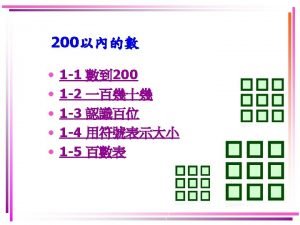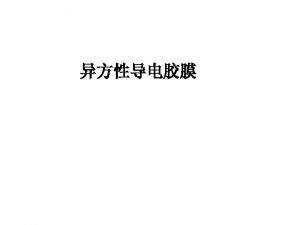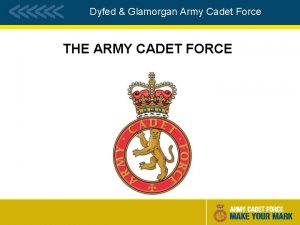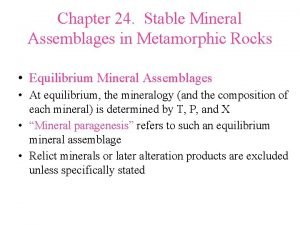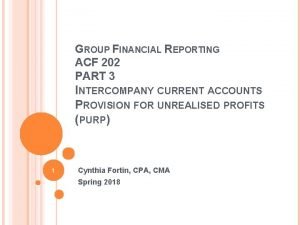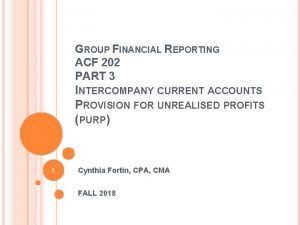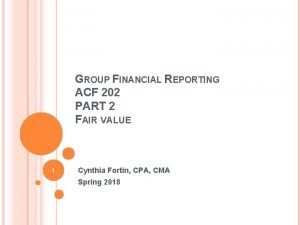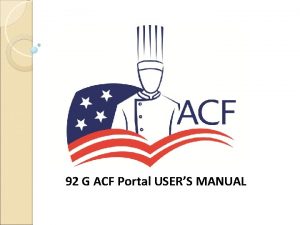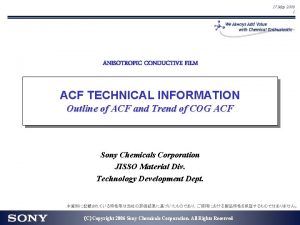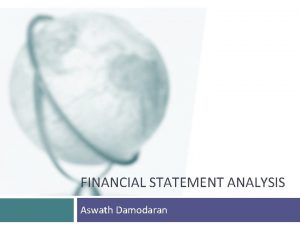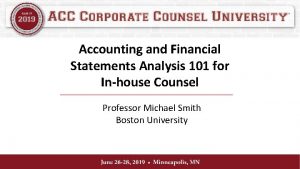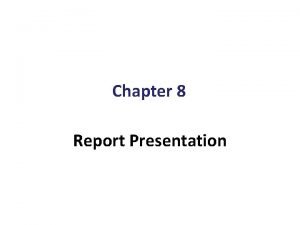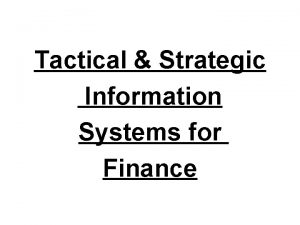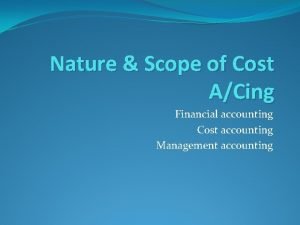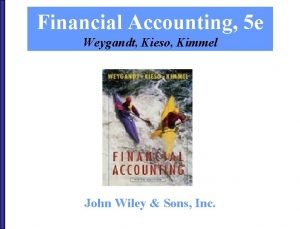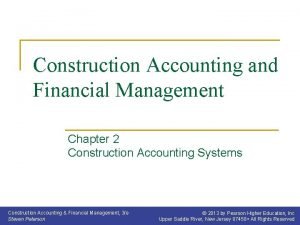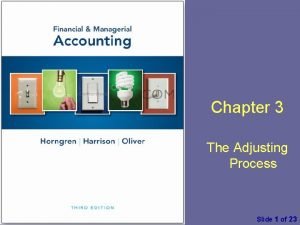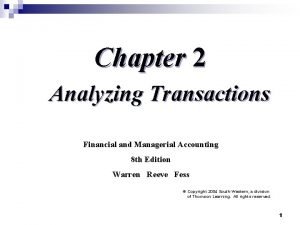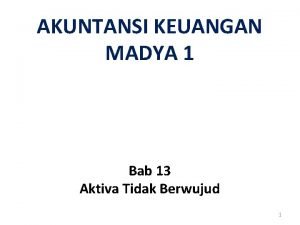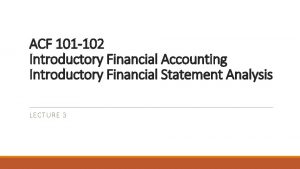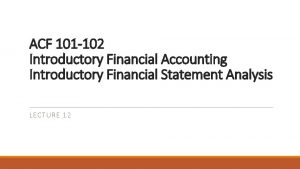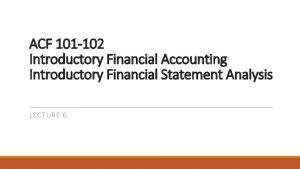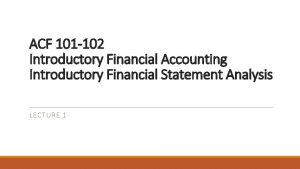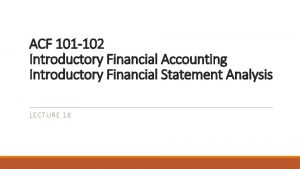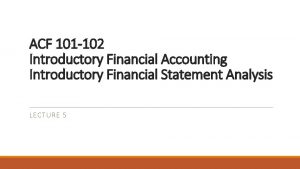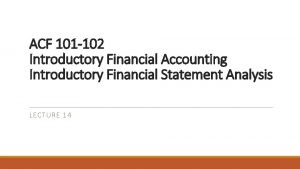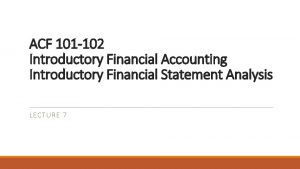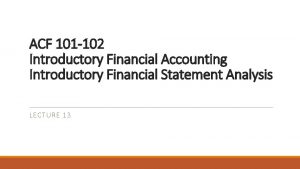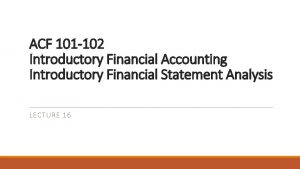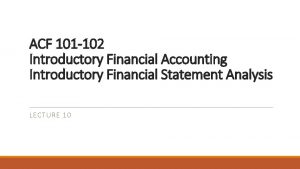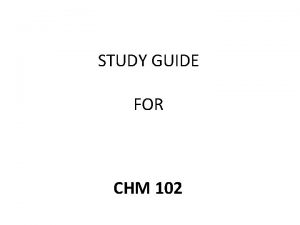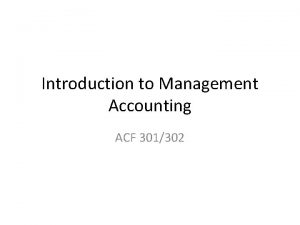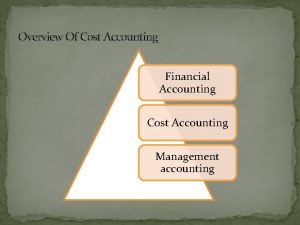ACF 101 102 Introductory Financial Accounting Introductory Financial



































- Slides: 35

ACF 101 -102 Introductory Financial Accounting Introductory Financial Statement Analysis LECTURE 11

Learning Outcome Demonstrate knowledge and understanding of types of analysis and also the accounting treatment of stock. Understand the usage of external financial reports. Understand the accounting concepts and conventions present in accepted accounting principles and their application in financial statements analysis.

Topics Inventory valuation Cost of sales (Cost of goods sold) Gross Profit

Gross Profit and Cost of Goods Sold Balance Sheet Income Statement Sales Minus Merchandise Purchases Merchandise Inventory Current Asset Merchandise Sales Cost of Goods Sold (an expense) Equals Gross Profit Minus Selling Expenses and Administrativ e Expenses Equals operating Income

Link inventory valuation to gross profit.

The initial step in assessing profitability in most firms examines gross profit.

Gross Profit = Sales – Cost of Goods Sold.

Gross Profit must be large enough to cover all other expenses as well as a desired profit.

Cost of goods sold is determined by subtracting the cost of goods not sold during the period (ending inventory) from the cost of goods available for sale (beginning inventory plus purchases during the period).

Use both perpetual and periodic inventory systems.

The two main systems for keeping inventory records are perpetual and periodic.

The perpetual inventory system keeps a continuous record of inventories and cost of goods sold that helps managers control inventory levels and prepare interim financial statements.

Purchase Systems Purchase inventory Merchandise Inventory Accounts Payable 960 Record revenue when inventory is sold Accounts Receivable Sales Revenue 1, 740

Purchase Systems Perpetual System – at each sale Cost of Goods Sold (COGS) Merchandise Inventory ◦ ◦ ◦ Beginning balance Purchases Available for sale Cost of goods sold Ending balance 870 100 + 910 1, 010 – 870 140 (Derived) _________________________________ ◦ Ending inventory count identifies spoilage, theft, etc.

Perpetual and Periodic Systems Ending inventory count ◦ Required under a periodic system ◦ A good control practice in a perpetual systems Firms often choose fiscal accounting periods so that the year ends when inventories are low External auditors usually observe a sample of the client’s physical count to confirm its accuracy

Cost of Merchandise Acquired Possible costs added to the inventory costs besides the purchase price itself ◦ Transportation (freight) in ◦ Handling ◦ Insurance Discounts that reduce these costs ◦ Quantity ◦ Early/quick payment ◦ Vendor rebates ◦ Purchase returns and allowances

Cost of Merchandise Acquired Returns, Allowances Merchandise Inventory (Purchases) 960 Accounts Payable 75 Purchase Returns/Allowances * 75 * Contra account to inventory or purchases Discounts Accounts Payable Discounts on Purchases Cash 885 5 880

Cost of Merchandise Acquired

Inventory Valuation Methods If inventory prices were not changing, all methods would produce the same COGS and ending inventory amounts. Since prices do change, which are assigned to COGS and ending inventory? Four methods are generally accepted: ◦ Specific identification - IFRS acceptable ◦ First-in, first-out (FIF 0) - IFRS acceptable ◦ Weighted-average - IFRS acceptable ◦ Last-in, first out (LIFO)

Inventory Valuation Methods Specific Identification The cost of each inventory item is known When an inventory item is sold, its cost becomes part of COGS. Bar codes facilitate identifying units and costs. Physical flow matches the accounting flow Relatively easy to use, especially for expensive lowvolume merchandise COGS/ending inventory easily manipulated if inventory prices are changing

Inventory Valuation Methods FIFO – First In, First Out Oldest costs are assigned to the income statement (COGS) Latest costs are assigned to the balance sheet (Inventory), making ratios computed there from more reflective of current market value Perpetual and periodic systems produce the same COGS and ending inventory amounts COGS can not be manipulated In periods of rising prices, FIFO leads to higher taxes paid and net income (by placing the lower costs in COGS)

Inventory Valuation Methods LIFO – Last In, First Out Oldest costs are assigned to the balance sheet (Inventory). Latest costs are matched to revenue on the income statement (COGS), making ratios computed there from more reflective of current market value Perpetual and periodic systems produce different COGS and ending inventory amounts COGS can be manipulated by buying inventory at year-end In periods of rising prices, LIFO leads to lower net income and lower taxes paid The Internal Revenue Code requires LIFO users for tax purposes to also use LIFO for financial reporting purposes Not permitted for IFRS users

Inventory Valuation Methods Weighted Average Computes a unit cost by dividing the total acquisition cost of all items available for sale by the number of units available for sale The weighted-average method produces gross profit somewhere between that obtained under FIFO and LIFO Perpetual and periodic systems produce different COGS and ending inventory amounts

Inventory Valuation Methods Example Assume a vendor of soft drinks starts out the week with no inventory He buys and sells cola as follows: ◦ Buys one can on Monday for 30 cents ◦ Buys one can on Tuesday for 40 cents ◦ Buys one can on Wednesday for 56 cents ◦ Sells one can on Thursday for 90 cents

Inventory Valuation Methods Example

Inventory Valuation Methods Miscellaneous Accountants often refer to inventory methods as cost flow assumptions May choose any of the four flows. Over long run, all produce essentially the same end results Three out of the four flows are not linked to the physical flow of merchandise Consistency suggests the cost flow assumption cannot be changed unless a substantive reason surfaces (must be disclosed)

Lower of Cost or Market Ending inventory should be valued at the lower of its cost ($45) or market value ($43) (Rarely record holding gains – conservatism) Market value ◦ Input market – replacement cost (i. e. LIFO cost) ◦ Output market – net realizable value (NRV) or NRV less a normal profit margin ◦ Market value – middle of those three numbers Loss on write-down of inventory Merchandise Inventory 2 2

Inventory Errors Revenue – recognized in the period when earned, realizable Expenses – recognized in the period when they helped to produce revenues Types of Errors ◦ Accidental (wrong amounts, accounts, GAAP, etc. ) ◦ Intentional – Profit pressures may cause managers to ◦ Delay the recording of purchases/expenses ◦ Accelerate incomplete sales orders

Inventory Errors

Inventory Gross Profit and Turnover Gross profit – Sales Revenue less COGS ◦ Expressed in dollar or percentage terms ◦ Sales Revenue $100, 000 100% ◦ COGS $60, 000 60% ◦ Gross Profit Margin $40, 000 40% ◦ Varies significantly by industry, wholesaler (lower due to volume) versus retailer (higher), presence of R&D, etc.

Inventory Gross Profit and Turnover Can also be used to save time counting ending inventory, assuming GPM is a constant 40% ◦ Sales Revenue $100 ◦ Cost of Goods Sold ? $60 ◦ Gross Profit Margin (40% x $100) $40 ----------------------------◦ Beginning Inventory $50 ◦ Purchases +$70 ◦ Ending Inventory – ? ? = $60 ◦ Cost of Goods Sold $60

Inventory Gross Profit and Turnover Gross profit percentage can be used to check the accuracy of the accounting records ◦ Unusually lower percentage may mean the company has tried to avoid taxes by failing to record all sales Some other factors that may cause a decline in the percentage are ◦ Price wars that reduce selling prices ◦ Shifting of the product mix sold ◦ Increase in shoplifting or embezzlement

Inventory Gross Profit and Turnover Inventory turnover Cost of goods sold Average Inventory 100, 000 20, 000 + 30, 000 = 4 2 ◦ On average inventory is being stocked/sold four times per year ◦ Higher turnover is associated with greater efficiency (lower costs associated with stocking/handling inventory) ◦ Effective in assessing companies in the same industry Days in inventory 365 days / 4 = 91. 25 ◦ On average inventory is held 91. 25 days before it is sold

Inventory Valuation Methods Miscellaneous Inventory shrinkage can result from many factors, including shoplifting or employee embezzlement The best deterrent for shoplifting is an alert employee at the point of sale Retail stores also use ◦ Sensitized tags on merchandise ◦ Surveillance cameras

Inventory Valuation Methods Miscellaneous Shrinkage Example ◦ Cost of inventory from a physical count ($8, 000) ◦ Inventory balance in the general ledger ($8, 200) Periodic system Already included in COGS Perpetual system Inventory Shrinkage Merchandise Inventory Cost of Goods Sold Inventory Shrinkage 200 200
 101 102 103 104 105 106 107 108
101 102 103 104 105 106 107 108 Is 107 a prime number
Is 107 a prime number Financial accounting chapter 1
Financial accounting chapter 1 Advanced corporate accounting ppt
Advanced corporate accounting ppt Acf 231
Acf 231 3m anisotropic conductive film adhesive 5363
3m anisotropic conductive film adhesive 5363 Values and standards of the acf
Values and standards of the acf Acf certification
Acf certification Army cadet force syllabus
Army cadet force syllabus Acf and akf diagrams
Acf and akf diagrams Aws academy cloud foundations (acf)
Aws academy cloud foundations (acf) Intercompany margin
Intercompany margin Purp in accounting
Purp in accounting Acf 202
Acf 202 Acf portal
Acf portal Sony acf
Sony acf Acf formula
Acf formula Aswath damodaran accounting
Aswath damodaran accounting Finance topics for discussion
Finance topics for discussion In-house financial statement
In-house financial statement Aasb 101 presentation of financial statements
Aasb 101 presentation of financial statements Computerized accounting information system
Computerized accounting information system Conservatism accounting principle
Conservatism accounting principle Tactical accounting and financial information system
Tactical accounting and financial information system Current cash debt coverage ratio
Current cash debt coverage ratio Scope management accounting
Scope management accounting Scope of financial accounting
Scope of financial accounting Accounting provides data or information on *
Accounting provides data or information on * Kimmel weygandt kieso financial accounting 5th edition
Kimmel weygandt kieso financial accounting 5th edition Construction accounting basics
Construction accounting basics Income statement in financial accounting
Income statement in financial accounting Managerial accounting chapter 2 solutions
Managerial accounting chapter 2 solutions Unit 5 lesson 2 financial accounting
Unit 5 lesson 2 financial accounting Unit 5 lesson 2 financial accountings
Unit 5 lesson 2 financial accountings Financial accounting chapter 13
Financial accounting chapter 13 Equity accounted investments
Equity accounted investments
